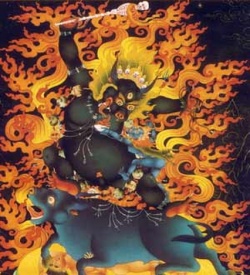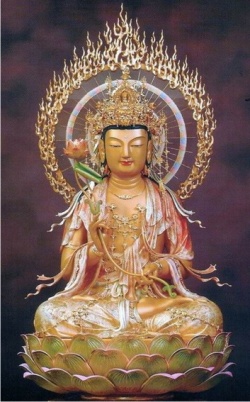Difference between revisions of "Seven emptinesses of Lankavatara"
| Line 174: | Line 174: | ||
| − | There are in short the [[emptiness]] This is the [[perfection of wisdom]] | + | ==There are in short the [[emptiness]] This is the [[perfection of wisdom]]== |
Revision as of 17:45, 22 June 2024
What the Buddhist term empty/emptiness (shunya/shunyata) means depends a lot on the context in which it is used.
For example, in the Lankavatara Sutra there are seven different emptiness'es.
“Replied Mahamati the Bodhisattva-Mahasattva, I will indeed, Blessed One.
The Blessed One said: Emptiness, emptiness, indeed! Mahamati, it is a term whose self-nature is [[false {imagination]].
Because of one's attachment to false imagination, Mahamati, we have to talk of emptiness, no-birth, non-duality, and absence of self-nature.
In short, then, Mahamati, there are seven kinds of emptiness:
1) The emptiness of individual marks (lakshana),
(2) the emptiness of self-nature (bhavasvabhava),
(3) the emptiness of no-work (apracarita),
(4) the emptiness of work (pracarita),
(5) the emptiness of all things in the sense that they are unpredicable (nirabhilapya),
(6) the [[emptinessii in its highest sense of ultimate reality realisable only by noble wisdom, and
(7) the emptiness of mutuality (itaretara) which is the seventh” (trans. D.T. Suzuki).
In the Pali canon, suñña (shunya) can mean lack, vacant, desolate, barren, lonely, absent, etc.
The Buddha tells Ananda that the temporal world (loka) is empty (suññam) of what belongs to the self which denotes a lack.
The message is, we should not look for our self in the temporal world—it ain’t there.
Also in the Pali canon we find (supreme or pure ultimate emptiness), viz., parisuddha paramanuttara suññata described in the discourse, Cula-Suññatâ Sutta, of the Majjhima-Nikaya.
This is a state which can only be described as mind that becomes utterly purified, or the same, pure Mind.
Mind is able to distinguish its own pristine nature from its most (subtle of phenomenalization), namely, animitta-ceto-samadhi ( the samadhi of the mind that is signless).
According to this Sutta, animitta-ceto-samadhi is still “(effected and thought out)” which means it is impermanent and liable to stopping.
Often in Mahayana Buddhism we find emptiness (shunyata) equated with suchness or tathata.
Suchness, we are to understand, is the (intrinsic substance or nature) (svabhava) of Mind which is the Mind that is Bodhi (bodhicitta).
In this sense emptiness is ontological or reveals the ontological rather than being the negation of all knowledge claims.
In Zen there is a difference between {nihilistic emptiness) and pure Mind which is empty of bewitching defilements.
From Zen master Tsung-mi we learn:
“Nihilistic emptiness means vacuity, openness, absence, or extinction.
It does not refer to the (Genuine Mind) (zhen shi xin).
This kind of emptiness) is without wisdom, without function, and cannot be found within dharmas.”
Again he says,
“The Nirvana Sutra, which says that “when there is nothing in a jar, the jar is said to be empty—it does not mean that there is no jar.”
In the same way, “when there are no discriminating thoughts such as desire or anger in the mind, the mind is said to be empty—it does not mean that there is no mind.
‘No mind’ (wu-hsin) only means that the defilements (fan-nao; klesha) have been eliminated from the mind.”
We can consider absolute Mind to be completely empty of any and all determinations—which, in itself, is a sheer, marvelous vacuity which is, nevertheless, real and dynamic.
Truth be told, the Buddha taught the emptiness or barrenness of phenomena; that they have no true nature.
He also taught the absolute or tathata to be empty of phenomena and determinations.
Skt. अध्यात्मबहिर्धाशून्यता, adhyātmabahirdhāśūnyatā, Pron.: adhyatmabahirdhashunyata
In short, then, Mahamati, there are ===seven kinds of emptiness===
(1) The emptiness of individual marks (lakshana),
(2) the emptiness of self-nature (bhavasvabhava),
(3) the emptiness of no-work (apracarita),
(4) the emptiness of work (pracarita),
(5) the emptiness of all things in the sense that they are unpredicable (nirabhilapya),
(6) the [[emptiness in its highest sense of ultimate reality realisable only by noble wisdom, and
(7) the emptiness of mutuality (itaretara) which is the seventh.
Sixteen kinds of emptiness
, or shunyata (Skt. ṣoḍaśaśūnyatā; Tib. tongnyi chudruk; Wyl. stong nyid bcu drug), which are mentioned in Chandrakirti's Madhyamakavatara:
1. emptiness of the outer
2. emptiness of the inner
3. emptiness of the outer and inner
4. great emptiness
5. emptiness of the beginningless and endless
6. emptiness of the conditioned
7. emptiness of the unconditioned
8. emptiness of emptiness
9. emptiness beyond extremes
10. natural emptiness
11. emptiness of the unobserved
12. ultimate emptiness
13. emptiness of the indispensable
14. emptiness of the essential nature of non-entities
15. emptiness of all phenomena
16. emptiness of specific characteristics
===18 Kausika Prajnaparamita emptiness'es:
emptiness of both subject and object,
emptiness of emptiness, the great emptiness,
[[emptiness]in the ultimate sense]],
[[conditioned] emptiness]],
emptiness without beginning and end,
emptiness of non-repudiation, emptiness of essential nature,
emptiness of the absence of a basis,
emptiness of non-existence, emptiness of own-being,
emptiness of the non-existence of own being.
There are in short the emptiness This is the perfection of wisdom
===Haribadhra's 20 kinds of emptiness===:
. Emptiness of the subject (adhyatma sunyata)
2. Emptiness of the external (bahirdha sunyata)
3. Emptiness of the subject and the externals (adhyatma-bahirdha-sunyata)
These first three emptiness;es have direct analogues in the Pali Discourses [N] The Great Emptiness Sutra (Maha-sunnata-sutta) of the Middle-lenth Discourses [MN: 122] refers to entering on and abiding in an internal emptiness (ajjhatta sunnata) an external emptiness (bahiddha sunnata), and an internal and external emptiness.
The internal emptiness refers to the emptiness of a monk’s own psycho-physical organism and the external emptiness, according to the commentary, refers to the emptiness of others’ psycho-physical organisms.
4. Emptiness of emptiness (sunyata-sunyata). This emptiness is presumably for countering the absolutization and reification of emptiness that Nargarjuna warns against (MK: 13.8)
5. The great emptiness (maha-sunyata). (The ten directions to which this emptiness refers are the eight cardinals, nadir and zenith)
6. The emptiness of the ultimate (paramartha-sunyata). For the madhyamika's’ grasping at nirvana, the ultimate, would preclude one from attaining it.
7. Emptiness of the conditioned (samskrta)
8. Emptiness of the unconditioned (asamskrta)
9. Emptiness of what has surpassed boundaries (atyanta).
Haribhadra interprets this as that which is beyond the extremes of nihilism (uccheda) and eternalism (sasvata.
10. Emptiness without a beginning or an end (anavaragra)
11. Emptiness of that which is not rejected (anavakara) (of what is gained, and required in the spiritual endeavor.)
12. Emptiness of a thing’s own nature (prakrtisunyata).
The unmade (akrta) state of things referred to in this emptiness means (MABh: 199) specifically not made by disciples, self-evolvers, bodhisattvas or the Tathagata, i.e. by design.
13. The emptiness of all phenomena (sarv-dharma)
14. The emptiness of self-defining properties (svalaksana).
This is the emptiness of the definitions or defining characteristics of all knowable's and is expanded at length (6.202-215) with definitions applicable to that which is basic to existence (6.202-204), the bodhisattva’s path (6.205-207) and the liberated state (moksa) (6.208-215)
15. The emptiness of the unobservable (anupalambha)
16. The emptiness of non-things (abhava). This is the emptiness of non-phenomenality, rather than nonphenomena.
The Perfect Insight in Twenty-five Thousand Stanzas [PPS] says that things have no entity because of relational origination (pratitya-samutpada) (Note: Also organization)
17. The emptiness of things (bhava)
18. The emptiness of non-things (abhava). The unproduced or permanent phenomena referred to are space and the two cessations (nirodha), i.e. nirvana and the non-analytical stases.
19. The emptiness of own nature (svabhava).
20. The emptiness of the other thing (parabhava)
Seven emptiness'es of Lankavatara
In short, then, Mahamati, there are seven kinds of emptiness:
(1) The emptiness of individual marks (lakshana),
(2) the emptiness of self-nature (bhavasvabhava),
(3) the emptiness of no-work (apracarita),
(4) the emptiness of work (pracarita),
(5) the emptiness of all things in the sense that they are unpredicable (nirabhilapya),
(6) the emptiness in its highest sense of ultimate reality realisable only by noble wisdom, and
(7) the emptiness of mutuality (itaretara) which is the seventh.
===Sixteen kinds of emptiness===, or shunyata (Skt. ṣoḍaśaśūnyatā; Tib. tongnyi chudruk; Wyl. stong nyid bcu drug), which are mentioned in Chandrakirti's Madhyamakavatara:





